Disclosure: We may earn commissions if you purchase products after clicking on a link from our site.
Are you interested in surf fishing? Do you want to learn how to surf fish? How to surf fish for beginners is not as challenging as it seems. With surf fishing, you don’t need a lot of equipment and you get easy access to the beaches to fish.
Additionally, you can catch a variety of fish when surf fishing. In this article, we share tips on how to surf fish, how to fish fishing spots, the equipment, you need as well as the baits and lures.
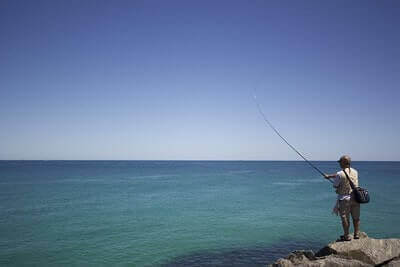
Table of Contents
How To Surf Fish For Beginners
1. You will have to learn how to surf cast if you are new to surf fishing. There is more emphasis on the distance and accuracy to land the bait in the surf. You will have to learn the exact speed and power needed to perfect the distance and accuracy when tossing out the line.
2. You will have to learn how to “read the beach” to find good fishing spots. Look for sand bars, outflows, or rip currents and areas of the beach with coarse sand and shells. These are areas where you will find fish waiting to ambush their prey. The best time to “read” the beach is when there is low tide. The low tide allows you to see the rock jetties, sand bars, deep holes, and other areas fish hang out.
3. Fish are very suspicious of shadows over the water as they associate shadows with predatory birds in the sky hovering to pick them up. When the sky is overcast or it is raining, it reduces shadows thereby making your bait more appealing. However, your safety must be paramount if it is raining, and be prepared to leave the shore if the rain gets stronger.
4. During high tide, you will find more fish will come to feed, especially early in the morning or late in the evening. Fish feel less vulnerable during the early morning or late evening and will come closer to the beach. If you want to learn how to surf fish for beginners, then studying the tides and how fish react to it is important.
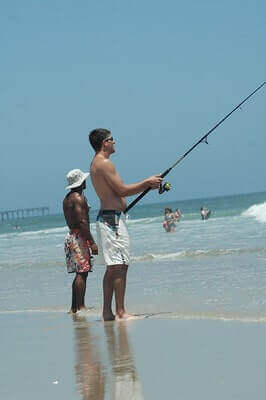
5. Locate fishing spots like dips, hollows, sandbars, troughs, points, seams, cover, and other structures fish like when the tide is low. This is one of the important things to learn when you want to understand how to surf fish for beginners.
6. It is good practice to surf fish with two poles. It allows you to target many species of fish. One pole is rigged for bigger fish while the other is set up for smaller fish.
7. Let your bait sink to the bottom after casting it. Add weight for it to stay at the bottom of the waves and currents are too strong and tend to take the weight toward the shoreline.
8. Do everything to keep the live bait alive as long as possible. The movement of a live bait attracts more bites. Rig your live baits through the nose, the top fin, or other areas that will not be fatal.
9. Soft baits can be made to mimic almost anything. Use soft baits when you don’t have live baits. They can be used off the bottom like you would with live bait. Additionally, soft bait with scent is more appealing.
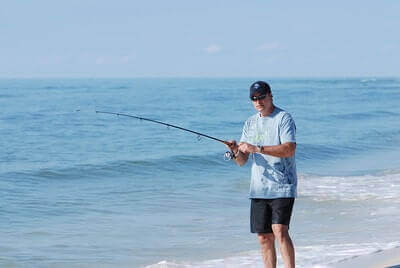
10. When you are fishing around structures in areas that need precise depth control, bucktail and maribou jigs work well there. When the situation requires finesse, jigs are a good option.
11. If you don’t know at which time there will be high and low tides, you can research it online or look at tidal charts for your area. Then be at the beach a few hours before the high tide which will usually be very early in the morning or hours before sunset. This is the time when you will get the most bites.
12. A medium-heavy 8-12 inch rod will work for fish surfing if the surf in that area isn’t very big. You can find rods of different lengths from 7 to 15 feet.
13. The size of the reels should match the size of the rods. Shorter rods match with reels in the size range from 1000 to 3000 and work for smaller fish. You will need reels in the range of 6000 to 8000 for bigger fish and longer casts.
14. You will need a leader when surf casting, especially if you are fishing around rocks and structures and if the fish has big teeth. A shock leader is recommended as it will reduce the chances of the line breaking and losing your tackle. Moreover, it makes it easier to handle the line.
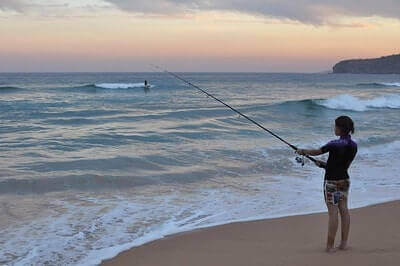
15. The most popular choice of a rig for surf casters is the fish-finder rig. It can be used for most species of fish and in most conditions. You will need a pyramid sinker with a swivel on the line, a 2-inch leader line, and a circle hook with cut bait.
16. When you are pulling a fish in, try to time bringing it in with the onrushing water that comes crashing on the shores. If you don’t take advantage of that incoming wave, trying to pull it in as the water goes back inward can be very difficult.
17. Many fish like flounder and kingfish feed outside of the area as the waves crash the shoreline. Try to fish close to the breakers.
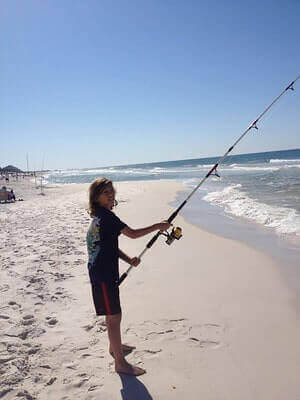
18. Check your state’s laws as some require a fishing license if you fish from the shoreline or from a pier.
19. Use a pair of polarized sunglasses to see through the glare and spot the fish.
20. For safety, wear an elastic wading belt when using chest waders. it prevents water from flowing inside in case you fall.
21. Place your surf rods in PVC sand pipes. This will protect the reels from rising tides and breaking surfs.
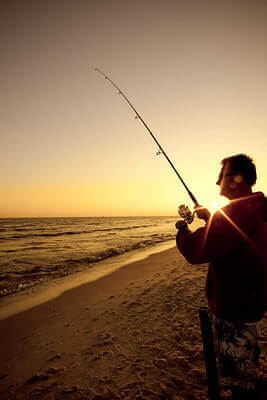
Live Bait For Surf Fishing
1. Shrimp
Shrimps are highly effective live baits for surf fishing, prized for their natural scent, lifelike movement, and ability to attract a wide variety of saltwater fish species. When used as bait, live shrimps can be rigged on a hook either whole or in sections, depending on the target species and fishing conditions. Their small size makes them ideal for enticing finicky fish in shallow coastal waters where other larger baits might not be as effective.
Shrimps are particularly appealing to predatory fish such as flounders, redfish, speckled trout, and pompano, which are known to forage along sandy beaches, tidal flats, and nearshore structures. Anglers often employ a variety of presentation techniques, including free-lining, bottom rigging, or under a float, to maximize the shrimps’ natural movement and increase their chances of enticing a strike.
Additionally, shrimps can be easily sourced from bait shops, caught using cast nets, or even collected from coastal waters, making them a convenient and versatile bait option for surf anglers.
2. Squid
Squid is a highly versatile and effective bait for surf fishing, prized for its strong scent, durability, and ability to attract a wide range of saltwater gamefish. When used as bait, squid can be rigged in various ways, including whole, as strips, or even as chunks, depending on the target species and fishing conditions.
Its natural oily texture and flavor make it particularly enticing to predatory fish such as striped bass, bluefish, flounders, and even sharks. Anglers often employ squid on a variety of rigs, including high-low rigs, Carolina rigs, or simply on a single hook with a weight to keep it anchored in the surf. Squid is also known for its durability, allowing anglers to cast it long distances without it falling apart easily.
Additionally, squid can be readily purchased from bait and tackle shops, making it a convenient and reliable option for surf anglers looking to entice a variety of saltwater species.
3. Mullet
Mullet is a popular bait choice for surf fishing due to its availability, versatility, and effectiveness in attracting a variety of saltwater gamefish. These fish are commonly found in coastal waters and estuaries, making them easily accessible to anglers.
Mullets can be rigged in different ways depending on the target species and fishing conditions. Whole mullet, cut into chunks, or filleted strips can all be used effectively as bait. Its natural scent and oily flesh make it highly attractive to predatory fish such as snook, redfish, tarpon, and sharks. Anglers often use mullet on a variety of rigs, including Carolina rigs, fishfinder rigs, or simply on a single hook with a weight to keep it in place in the surf.
Additionally, mullets can be caught using cast nets or purchased fresh or frozen from bait shops, providing anglers with a convenient and reliable bait option for surf fishing adventures.
4. Minnows
Minnows are a versatile and widely used bait for surf fishing, valued for their natural movement and ability to attract a variety of predatory fish species. Whether they’re native to the area or purchased from bait shops, minnows can be effective in enticing a range of saltwater gamefish such as snook, redfish, trout, flounder, and even larger species like tarpon and sharks.
Anglers often rig live minnows on a variety of setups, including Carolina rigs, fishfinder rigs, or under-popping corks to keep them suspended in the water column. Additionally, dead or cut minnows can be used as bait for bottom fishing rigs or cut into chunks to attract larger fish. The size of the minnow used can vary depending on the target species and fishing conditions, with larger minnows typically appealing to bigger predators.
Overall, minnows offer anglers a natural and effective bait option for surf fishing adventures, providing both seasoned and novice anglers with the opportunity to hook into some exciting catches along the shoreline.
5. Herring
Herring is a popular bait choice for surf fishing, prized for its oily flesh and strong scent that can attract a wide range of predatory fish species. Whether fresh or frozen, herring can be rigged in various ways to target different types of fish found along the shoreline.
Anglers often thread whole or chunked herring onto hooks as bait for species like striped bass, bluefish, redfish, and even sharks. The natural shine and movement of herring in the water make it a particularly enticing option for larger gamefish.
Additionally, herring can be used in conjunction with other baits or as part of a larger bait spread to increase the chances of attracting fish. Its versatility and effectiveness make herring a go-to choice for surf anglers looking to hook into some exciting catches while casting from the beach or pier.
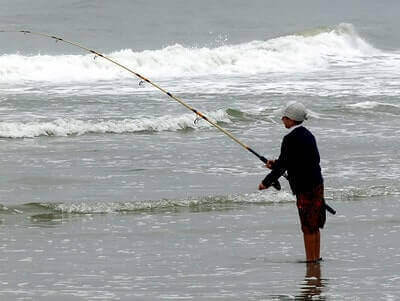
Surf Fishing Gear
1. Rods
Rods are essential gear for surf fishing, designed to handle the unique challenges of casting bait or lures into the surf and battling large fish from the shoreline. Surf fishing rods are typically longer and more robust than other types of fishing rods, ranging from 9 to 15 feet in length to allow anglers to achieve greater casting distances and keep their lines above the breaking waves.
These rods are often constructed from durable materials like graphite or fiberglass to withstand the rigors of saltwater environments and the powerful pulls of ocean-dwelling gamefish. Additionally, surf fishing rods feature sturdy reel seats and guides designed to accommodate heavy-duty reels and lines necessary for targeting large species such as striped bass, redfish, bluefish, and sharks.
With their extended length, strength, and specialized construction, surf fishing rods provide anglers with the leverage and casting performance needed to successfully tackle the challenges of surf fishing and reel in trophy catches from the shore.
2. Spinning reels
Spinning reels are indispensable tools in the arsenal of surf fishing gear, offering versatility, ease of use, and reliable performance for anglers targeting a variety of saltwater species from the shoreline. These reels feature an open-faced design with a bail mechanism that allows for efficient casting and smooth line retrieval, making them ideal for surf fishing where long-distance casts are often required.
Spinning reels are prized for their ability to handle a wide range of fishing lines, from monofilament to braided, enabling anglers to adapt their setups to different surf conditions and target species. With their durable construction and corrosion-resistant materials, such as aluminum or graphite, spinning reels can withstand the harsh saltwater environment and the powerful runs of gamefish like striped bass, bluefish, and red drum. Their user-friendly design makes them accessible to anglers of all skill levels, allowing both beginners and seasoned veterans to enjoy the thrill of surf fishing and reel in trophy catches from the surf.
3. Line
A high-quality fishing line is a crucial component of surf fishing gear, serving as the lifeline between angler and catch in the dynamic environment of the shoreline. When selecting a fishing line for surf fishing, durability, strength, and abrasion resistance are paramount considerations, as the line must withstand the rigors of casting through rough surf, abrasive sand, and potential encounters with sharp rocks or debris.
Monofilament lines are popular for their stretch and forgiveness, making them well-suited for absorbing the shock of powerful strikes from hard-fighting species like striped bass or surfperch. Braided lines offer superior strength and sensitivity, allowing anglers to detect subtle bites and set the hook quickly, crucial advantages when targeting elusive or finicky fish in the surf zone. Fluorocarbon lines provide low visibility and sink quickly, ideal for presenting baits or lures naturally in turbulent surf.
Regardless of the type chosen, a properly spooled and maintained fishing line is essential for maximizing casting distance, sensitivity, and landing rates in the challenging and rewarding realm of surf fishing.
4. Leader
A leader is an essential component of surf fishing gear, serving as a crucial link between the main fishing line and the bait or lure. In the dynamic and often turbulent environment of the surf, leaders provide several key advantages. First and foremost, they act as a buffer against the abrasive effects of sand, rocks, and sharp underwater structures, helping to prevent break-offs and ensuring the integrity of the fishing rig.
Additionally, leaders can enhance presentation by providing stealth and reducing visibility, especially in clear water conditions or when targeting wary species. Leaders come in various materials, including monofilament, fluorocarbon, and wire, each offering specific benefits depending on the fishing situation and target species.
Monofilament leaders provide flexibility and shock absorption, while fluorocarbon leaders offer low visibility and abrasion resistance. Wire leaders are indispensable when targeting toothy predators like bluefish or barracuda, providing protection against their sharp teeth. Overall, incorporating a well-chosen leader into your surf fishing setup can significantly improve your chances of success by increasing durability, stealth, and overall effectiveness in challenging coastal environments.
5. Sinker
A sinker, also known as a weight or lead, is a fundamental piece of surf fishing gear designed to serve multiple purposes in varying surf fishing conditions. Its primary function is to provide the necessary weight to cast bait or lures beyond the breaking waves and into deeper waters where fish often congregate.
By adding weight to the fishing line, sinkers enable anglers to achieve greater casting distance and accuracy, allowing them to reach prime fishing spots beyond the shoreline. Sinkers come in a range of shapes and sizes, including pyramid, egg, bank, and coin-shaped designs, each suited to different surf and bottom conditions. Pyramid sinkers, for example, are ideal for holding bottom in sandy or shifting terrain, while bank sinkers excel in rocky or snag-prone areas.
Additionally, sinkers play a critical role in maintaining the position and presentation of baits or lures in the water column, helping to keep them at the desired depth and enticing target species to strike. Overall, sinkers are essential components of surf fishing gear, providing anglers with the casting distance, accuracy, and bait control necessary for successful fishing outings along the coastline.
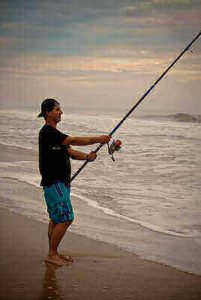
Artificial Lures For Surf Fishing
1. Jigs
Jigs are versatile artificial lures widely used by surf anglers to target a variety of saltwater species in coastal waters. Consisting of a weighted head and a hook adorned with a skirt or soft plastic body, jigs mimic the appearance and movement of prey fish, crustaceans, or other forage items, making them highly effective in enticing predatory fish to strike.
When retrieved through the water, jigs exhibit a darting, erratic motion that closely resembles the natural movements of injured or fleeing baitfish, triggering predatory instincts in gamefish such as striped bass, bluefish, redfish, and flounder.
Anglers can customize jigs with different types and colors of skirts or bodies to match prevailing forage or water conditions, increasing their effectiveness in enticing strikes. Jigs can be cast from shore or boat and are often fished near the bottom or along the edges of structures, including jetties, sandbars, and submerged rocks, where predatory fish are known to ambush their prey.
Their compact size and weight allow for long casts, making them ideal for reaching distant feeding grounds beyond the surf zone. Whether worked with a steady retrieve, jigged vertically or bounced along the bottom, jigs are a go-to lure choice for surf anglers seeking action-packed fishing adventures along the coastlines.
2. Soft Plastic Baits
Soft plastic baits are a staple in the arsenal of surf anglers, offering versatility, realism, and effectiveness in enticing a wide range of saltwater species. These lures typically consist of soft, pliable materials molded into various shapes and sizes, resembling baitfish, crustaceans, or other natural forage.
Soft plastic baits can be rigged on a jighead, Texas-rigged, Carolina-rigged, or used with a weighted hook, providing anglers with multiple presentation options to suit different fishing scenarios and target species. Their lifelike appearance and action, coupled with the ability to impart subtle movements or erratic twitches, make them irresistible to predatory fish prowling the surf zone.
Anglers can choose from an extensive array of colors, patterns, and sizes to match prevailing baitfish or water conditions, increasing their chances of success. Whether cast and retrieved steadily, hopped along the bottom, or worked with a twitch-pause retrieve, soft plastic baits excel in enticing strikes from a variety of gamefish, including striped bass, flounder, bluefish, redfish, and speckled trout. With their proven effectiveness and adaptability, soft plastic baits remain a go-to choice for surf anglers seeking to hook into trophy fish along the coastal shores.
3. Spoons
Spoons are a popular choice among surf anglers as artificial lures for targeting a variety of saltwater species. These lures feature a sleek, metallic design that mimics the appearance of baitfish, making them highly attractive to predatory fish such as striped bass, bluefish, Spanish mackerel, and redfish.
When retrieved through the water, spoons produce an enticing wobbling action and flash that simulates the movement of injured baitfish, triggering aggressive strikes from hungry predators. Anglers can cast spoons directly into the surf and retrieve them at varying speeds to mimic the behavior of fleeing prey, or they can be trolled from boats along the shoreline to cover more ground and locate feeding fish.
Available in a range of sizes, colors, and finishes, spoons can be customized to match the prevailing baitfish species or to suit specific fishing conditions. Their versatility and effectiveness make them a valuable addition to any surf angler’s tackle box, providing exciting opportunities for action-packed fishing adventures along the coast.
4. Topwater Poppers
Topwater poppers are highly effective artificial lures for surf fishing, known for their ability to elicit explosive strikes from aggressive predators such as striped bass, bluefish, and redfish. These lures feature a buoyant body and a concave face that creates a popping or splashing sound when retrieved across the water’s surface.
This commotion mimics the behavior of wounded or struggling baitfish, attracting nearby predators and prompting them to strike. Anglers can achieve different actions by varying their retrieve speed and cadence, allowing them to imitate the movements of injured prey and entice strikes from hungry fish.
Topwater poppers are particularly effective during low-light conditions or when targeting fish feeding near the surface, making them a favorite choice among surf anglers looking for heart-pounding surface strikes and adrenaline-filled fishing experiences. With their exciting action and proven fish-catching ability, topwater poppers are essential additions to any surf angler’s tackle arsenal.
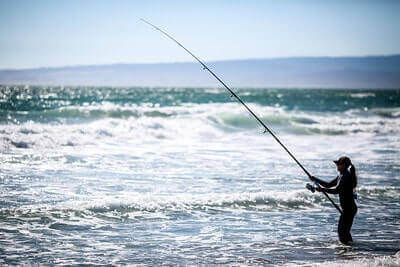
The Bottom Line
Surf fishing tips are easy to understand and put into practice. Surf fishing allows you to catch a variety of fish at the beach without a lot of gear or a boat. It is a great way for beginners to learn how to fish as it is easy to learn. In addition to returning home with a cooler filled with fish, surf fishing is very relaxing. In this article, we share tips to help you learn how to surf fish as a beginner.
If you catch black drum, then this article about black drum fishing tips will help you catch more black drum. Bullhead fishing tips will also help you catch more bullheads if you fish for bullheads.